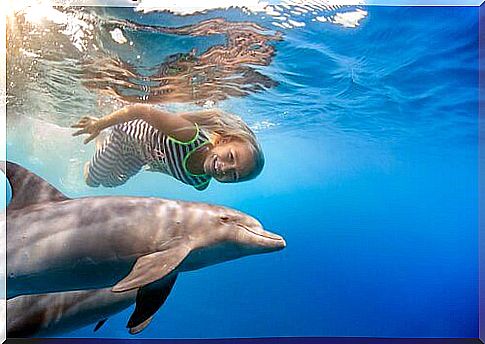Do Captive Dolphins Really Suffer?

The training of dolphins in artificial swimming pools , for the purpose of human entertainment, has always generated a lot of controversy. These cetaceans also participate in the rehabilitation and stimulation of children and adults with disabilities. But the central question is always the same: do captive dolphins suffer, or not?
Major dolphinaria around the world
Currently, it is estimated that over 2,000 cetaceans live in captivity, in aquariums spread across 60 countries. Although most of these cetaceans are dolphins and killer whales (belonging to the Delphinidae family ), we also find porpoises and belugas in water parks.
The first dolphinarium was inaugurated in Florida (United States), during the 1930s. Since that time, whale shows have been hugely successful around the world and the number of marine zoos has multiplied.
In Italy, currently, there are 4 dolphinariums: the Aquarium of Genoa, the Delphinarium of Fasano, the Park of Oltremare (Riccione) and the Zoomarine of Rome (between Torvaianica and Pomezia). In Europe, the largest concentration of captive dolphins is in Spain, where there are 12 dolphinaria. Japan, China, the United States, Mexico, Russia and Ukraine have even more.
Currently, despite the scientific data showing the suffering of captive dolphins, they continue to represent a secure source of income. Indeed, commercial dolphin farming is considered an “emerging market” in countries such as Russia, Japan, China and Mexico.

The fictional tale of happy dolphins: cinema and TV
The film and television industry has created a fantastic image of dolphins, built specifically to surprise children. Big and small, in fact, are fascinated by the adventures of famous dolphins such as, for example, the famous Flipper. From an early age, young people around the world get used to the friendly smile of dolphins in swimming pools.
However, many captive cetaceans exhibit numerous symptoms of stress, anxiety and depression. The fact that they don’t show these moods in their performances doesn’t mean they don’t feel negative emotions.
In reality, the dolphin is an extremely sensitive and intelligent animal that communicates mainly with gestures and sounds. Cetaceans rarely use expressions to express their feelings or emotions. Therefore, we must stop believing that a dolphin is constantly smiling .
The capture of dolphins for shows
Have you ever wondered how a dolphin arrives in a water park?
Almost all cetaceans in captivity have been captured in their natural habitat and violently deprived of their freedom. The cases of dolphins that were born to parents who already lived in the dolphins, in fact, are very rare cases.
The capture is an aggressive process which exposes the animals to a very high level of stress, risking their lives. Basically, the cetaceans are followed and surrounded by various boats, with the aim of directing them to a certain trap. Many times, explosives are even used to scare the dolphins and force them to move in a certain direction.
Some countries, such as the United States and Mexico, “defend themselves” by claiming that the capture of cetaceans is prohibited in their legislation. However, having dozens and dozens of very profitable dolphinaria, they cannot explain why and how these centers always manage to have new specimens to show to the public …

As the death rate is relatively high in dolphinaria, the capture of wild cetaceans continues to be a reality. Numerous animals are currently captured in the seas of Cuba, Japan, Russia, China, Indonesia and on the extensive African coast.
Dolphins in captivity live poorly and die sooner
It goes without saying that cetaceans, like all animals in captivity, live in completely artificial environments . A dolphin swimming freely in the ocean must get used to the small pools that are chemically treated. In addition to becoming more sedentary, these cetaceans become vulnerable to allergies and inflammation due to chlorine and alterations in the pH of the water.
On the other hand, due to the contact with the public, these specimens are exposed to constant overexcitation. During “shows” and during training, these animals have to endure loud music, shouts, fireworks and other noises. All this generates an absolutely stressful context.
Another detrimental aspect of dolphinaria is the lack of shade and the shallow depth of the pools. Since the skin and mucous membranes of cetaceans are sensitive, excessive exposure to solar radiation is very dangerous. Most often, sunburns are observed in captive dolphins.
Finally, we must mention the lack of environmental enrichment in dolphinaria. Cetaceans are curious and intelligent, so they should always be mentally stimulated to stay healthy and happy.
In their natural habitat , these animals would naturally explore every corner of the sea. But dolphins in captivity are subject to a monotonous reality, which favors the development of numerous ailments, both physical and mental.









